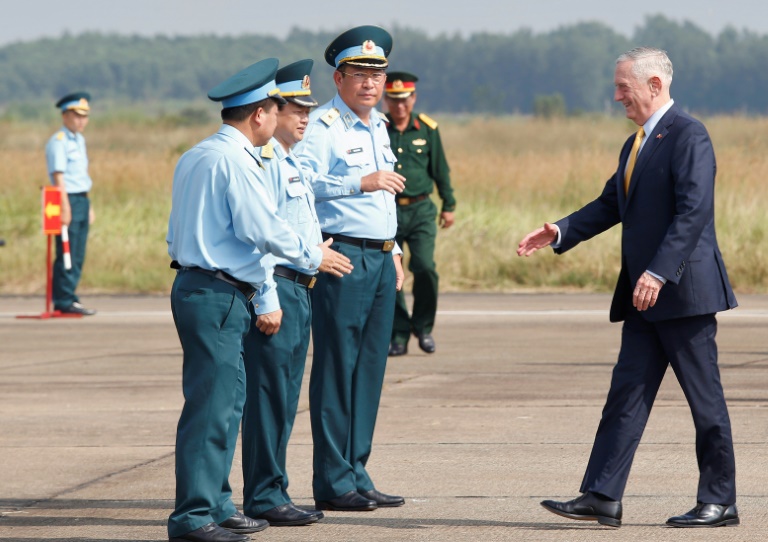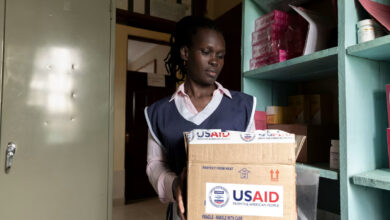
US Defense Secretary Jim Mattis toured a former Agent Orange storage site in southern Vietnam on Wednesday, revisiting one of the war’s darkest chapters that lives on among a million Vietnamese with severe birth defects, cancers and disabilities linked to the toxic defoliant.
Standing near a weedy field contaminated with dioxin, Mattis surveyed a map of the Bien Hoa airport outside Ho Chi Minh City, one of the main staging grounds for Agent Orange that was hastily cleared by soldiers near the war’s end more than four decades ago.
US forces sprayed 80 million liters (21 million gallons) of Agent Orange over South Vietnam between 1962 and 1971 in a desperate bid to flush out Viet Cong communist guerrillas by depriving them of tree cover and food.
At Bien Hoa the spillover from the clearing operation is believed to have seeped beyond the base and into the ground water, rivers and the local food chain and is linked to severe mental and physical disabilities across generations of Vietnamese — from enlarged heads to deformed limbs.
Under a 10-year remediation effort led by development agency USAID, work is set to start next year on cleaning up Bien Hoa, one of the largest dioxin “hotspots” remaining in Vietnam.
“We hope to have shovels in the ground next year sometime,” said a USAID official who was not authorized to be quoted by name.
Vast amounts of Agent Orange had been stored at Bien Hoa in large fuel containers during the war, and under a 1972 operation called Pacer Ivy the US military began pulling the chemical from Vietnam for storage and disposal outside the country.
“In that operation of repackaging, there was a lot of spillage obviously and so that is what we are faced with,” the official said.
– ‘Keeping our promise’ –
The pledge to clean up the site came under the administration of Barack Obama, and will cost some $390 million, officials said.
Hanoi says up to three million Vietnamese people were exposed to Agent Orange, and that one million suffer grave health repercussions today, including at least 150,000 children with birth defects.
An attempt by Vietnamese victims to obtain compensation from the United States had little success, and the US Supreme Court in 2009 declined to take up the case while neither the US government nor the chemical manufacturers have ever admitted liability.
Mattis said visiting the site was part of a US commitment to make amends for parts of the bloody and bitter war that killed an estimated three million Vietnamese.
“We had promised to help… so this is America keeping her promise to remediate some of the past,” Mattis, whose older brother served in Vietnam during the war, told reporters this week.
“I just want to get eyes on (the site) so when I go back and I talk to Congress, I can tell them my impression with actually having seen the site,” Mattis said ahead of the trip.
He spent only a few minutes at the site meeting with Vietnam military officials near a “hazardous material” warning sign.
– Bury the hatchet –
Ties between the former foes have warmed considerably since the end of the war and today Washington is one of Hanoi’s closest political and military allies and trading partners.
This is Mattis’s second trip to Vietnam this year after a January trip to Hanoi, which was followed by a historic visit by a US aircraft carrier in March, the first to Vietnam’s shores since the war in a symbolic burying of the hatchet for both sides.
In addition to Bien Hoa, the US and Vietnamese have identified two other “dioxin hotspots” — Danang and Phu Cat airbases.
A project to clean up Danang has just been completed at a cost of $110 million. The Bien Hoa cleanup operation is four times the size of the one in Danang, the USAID official said.
Chuck Searcy, a US veteran who served in Vietnam 1967-68 and now lives in Hanoi, said he was happy Mattis’s trip included a stop at Bien Hoa and hoped it would lead to more funding for the dioxin clean up.
“His visit is important because it reflects a commitment on the part of the Department of Defense to be involved with this issue in a positive way,” said Searcy, who works with Project RENEW which clears unexploded ordnance in Vietnam.
“A lot of us have been waiting for that to happen for quite a long time, so this is encouraging,” he told AFP.




